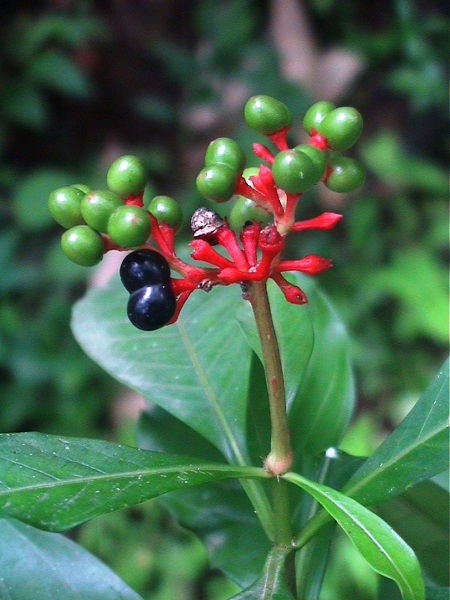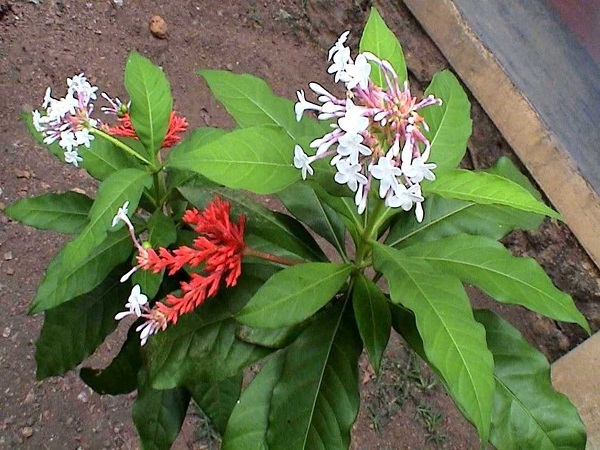
| Family | Apocyanceae |
| English Name | Sarpagandha, Indian Snakeroot |
| Malayalam Name | Amalpori, sarpagandhi |
| Tamil Name | Chivan melpodi, sarpaganthi |
| Kannada Name | Haavukannina gida, shivanabhi, sarpagandhi |
| Telugu Name | Dumparasna, Sarpagandhi |
| Hindi Name | Nakulikanda, sarap-gandha, candrabhaga |
| Sanskrit Name | Sarpasugandha, sugandha, vasupushpa, vishamardani |
| Trade Name | Sarpagandha, Indian Snakeroot |
| Part Used | Roots |
| In Wild | Yes |
| Under Cultivation | Yes |
| Temperature | 10-38 (in Centigrades) |
| Rainfall | 1500-3500 mm |
| Farmers | NA |
| Traders | NA |
| Institution | NA |
| Individually | NA |
| State/Region | NA |
| District | NA |
| Nursery Information | NA |
| Yield | On an average, root yield varies from 15 to 25 quintals/ha of dry weight under irrigation depending upon soil fertility, crop stand, and management. |
| Economic of cultivation | Cost of cultivation: One acre 20,000 plant x Rs 7 per plant = Rs 1,40,000/- ( including plants, transportation, supervision, consultancy) Per acre fertilizer one year. = Rs.20,000/- Land development = Rs.10,000/- Labour = Rs.15000/- Total expenses for one year = Rs.1,85,000/- Income : 100 kg seed within the first year of plantation. In total two-year income 200 kg seeds x 1500 Rs per kg buy back = Rs. 3,00,000 /- 2000 kg dried roots within the second year of plantation. 2000 kg dried roots x 300 Rs. per Kg buy back = Rs. 6,00,000 /- Two Years Total Income = Rs. 9,00,000/- |
| Quantitative quality standards | • Foreign matter: Not more than 2.0 per cent • Ash: Not more than 9.0 per cent • Acid-soluble ash: Not more than 3.0 per cent • Ethanol-soluble extractive: Not less than 4.5 per cent • Water-soluble extractive: not less than 9.0 per cent |
| Description | NA |
| Agro technology/Cultivation practices | 1. Planting-stock production: The crop can be propagated by seed, stem cutting, and root cuttings. Seed propagation is the best method for raising commercial plantation. 1.1 By root cutting: Nearly 5 cm long root cutting is planted during spring season closely in nursery beds containing well-matured FYM, sand, and saw-dust. 1.2 By stem cutting: Hard wooded stem cutting measuring 15 to 22 cm are closely planted during June in the nursery beds where continuous moisture is maintained. 1.3 By root stumps: About 5 cm of roots, intact with a portion of stem above the collar, are directly transplanted in the field having irrigation facilities. 1.4 By seed: Seed germination in Rauwolfia is highly variable. It is reported to vary from 5 to 30 per cent even when only heavy seeds are chosen for sowing purpose. Light and heavy seeds can easily be separated by simple water flotation. Germination of heavy seeds during May-June after soaking them in water for 24 hours was 20-40 per cent and 62.77 % germination was recorded in freshly collected heavy seed lot. In all, 6 kg of seeds is sufficient to raise one-hectare plantation. The seeds are sown, 2-3 cm apart in rows in shallow furrows of nursery beds. The furrows are then covered with a fine mixture of soil and FYM. Keep the beds just moist by light watering. Germination starts after 15-20 days and continues up to 30 to 40 days which were ready for transplantation. 2. Field planting: The seedlings are transplanted at 30 cm distance within the rows spaced at 45 cm. If rains are not received during or immediately after transplantation irrigation is necessary for a better stand. Rauwolfia is a long duration (18 months) and slow growing. 3. Manuring/Fertilization: Organic manures like Farm Yard Manure (FYM), Vermi-Compost, Green Manure etc. may be used as per requirement of the species. 4. Irrigation: The plant, If grown in areas which receive rainfall of 150 cm or above well distributed throughout the growing season such as in Assam and Kerala, can be raised and rainfed crop under subtropical conditions. It needs regular irrigation where the temperature rises high combined with low rainfall during the rainy season. It is suggested that 15 to 16 irrigations, amounts to irrigation at 20 days interval in summer and at 30 days interval in winter. 5. Diseases/pests: It is susceptible to various diseases like leaf spot, mosaic, leaf blotch, leaf blight and bud rot. A very few pests have been recorded. pyralid caterpillar causes appreciable damage to the leaves. To prevent diseases, bio-pesticides could be prepared (either single or a mixture) from Neem (kernel, seeds & leaves), Chitrakmool, Dhatura, Cow urine etc. |
| Harversting | Root yields at different age and season have shown that 18 months duration crop produce maximum root yield. The harvesting period coincides with the shedding of leaves during the early autumn season next year. At this stage, the roots contain a maximum concentration of total alkaloids. At harvest, the root may be found to go up to 40 cm deep in the soil. Harvesting is done by digging up the roots and thin roots are also collected. |
| Processing | After digging the roots are cleaned, washed and cut into 12 to 15 cm pieces for convenience in drying and storage. The dry roots possess up to 8-10 per cent of moisture. The dried roots are stored in polythene lined gunny bags in cool dry place to protect it from the mould. |
| References | NA |

